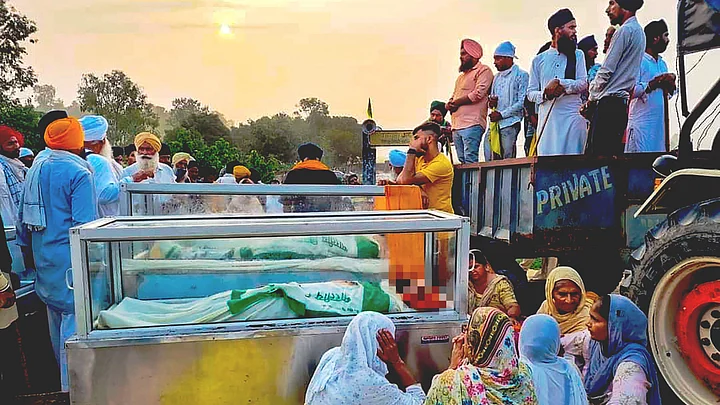Governments do not like to lose — we, the people, have trained them to be the ‘mai-baaps', the 'overlords’ who know the best about our interest. Democracy does not support this hierarchy, but the Indian voter does. The result is what we see in Uttar Pradesh's Lakhimpur and across the country, where the state machinery is fighting citizens of its own country.
Governments believe they have the support of the voters when they use force and state violence to suppress protests. Voters are blind-sided by media that ensure that only government propaganda reaches the audience and gets validated by the news.
'Goons in Disguise', Roadblocks: How TV Channels Covered Lakhimpur
Rate The Debate (RTD), the media watchdog under the Institute of Perception Studies, New Delhi, has been researching media handling of the farmers’ protests for the past 10 months. After yesterday’s Lakhimpur Kheri deaths, the RTD studied the media coverage by taking a sample of 19,800 seconds of footage between 11 a.m. and 11.30 a.m. on 4 October, 2021. Following are some of the findings for 11 channels:
Aaj Tak debated on Lakhimpur violence and whether or not politicians should visit Lakhimpur at this time.
India Today focused on the Lakhimpur violence, detention of opposition politicians, while also covering Aryan Khan’s arrest by the Narcotics Control Bureau.
NDTV 24X7 has covered aspects of the Lakhimpur violence and stopping/detention of opposition leaders by the Uttar Pradesh Police.
News24 has asked balanced questions to all parties involved, pertaining to the action and inaction by all stakeholders, accused and victims in the Lakhimpur incident.
Zee News has shown the house-arrests of opposition politicians and explored whether opposition parties are attempting to just gain political mileage in the poll-bound state.
Republic World has focused on the police jeep that was burnt in Lucknow in response to the Lakhimpur violence and related it to farmers protest.
CNN News18’s coverage was related to the shutdown of the Delhi-UP border that left commuters in the lurch and turned the onus on farmers’ protest.
News18 Hindi, in addition to the same coverage as CNN News18, covered the protests by Akhilesh Yadav and the Congress and conducted interviews of Ajay Kumar Mishra, Union Minister of State for Home, and his son Ashish Mishra.
NDTV India has done ground spot reports and covered the detention of opposition politicians.
ABP News focused on their electoral show — Shikhar Sammelan — wherein issues in the Punjab government were being discussed with a sitting minister from the Punjab Government.
Republic Bharat asked if the Lakhimpur farmers are goons in disguise by showing videos of alleged violence, but made no mention or showed no video(s) of the farmers who were killed at Lakhimpur.
How Media Villainised Protesting Farmers
Earlier in February 2021, the RTD had conducted research on Anchor Language Analysis, or ALA. This provided findings on the most-used words phrases and sentences by TV channels while covering farmers’ protests.
Most-used words: For example, during the winter months, the images of the farmers struggling to survive in the open outside Delhi began to hurt. A narrative was generated in TV channels that tried to argue that the farmers were not really suffering in the cold, but were well-supported by vested interests. The most used words in the coverage of farmers protest during that time were ‘Event Management’ and ‘5-Star Kisans’.
Most-used phrases: Directional usage of phrases has been done to address farmers protests. For example, the phrases used were Videshi Takat (foreign power), Andolanjeevi (activists), Vampanthi (Leftists) and Tukde-Tukde gang. Protests were called ‘Bharat Ke Dushman’ (enemies of India) and even Khalistanis.
Most-used sentences: The protesting farmers and their movement was described as: “This is one the biggest contracts of one of the biggest event management companies in India”; “Soon, MBA will stand for ‘Master of Business Aandolan’, not ‘Master of Business Administration’”; “Khalistanis have entered the farmers’ protests”; “Someone else controls these puppets”.
This is not the first time that the poor and the powerless in India have been crushed under the wheels of the state. It is not the first time that voices of dissent and protest are being shut down. But every time this has happened in history, from Emergency to Nirbhaya, the governments had to face an awakened voter and lose power. There is no such thing as blind obedience in a democracy.
(Dr Kota Neelima is an author and researcher with the Institute of Perception Studies, and writes on rural distress and farmer suicides. She tweets @KotaNeelima. This is an opinion piece. The views expressed are the author’s own. The Quint neither endorses nor is responsible for them.)
